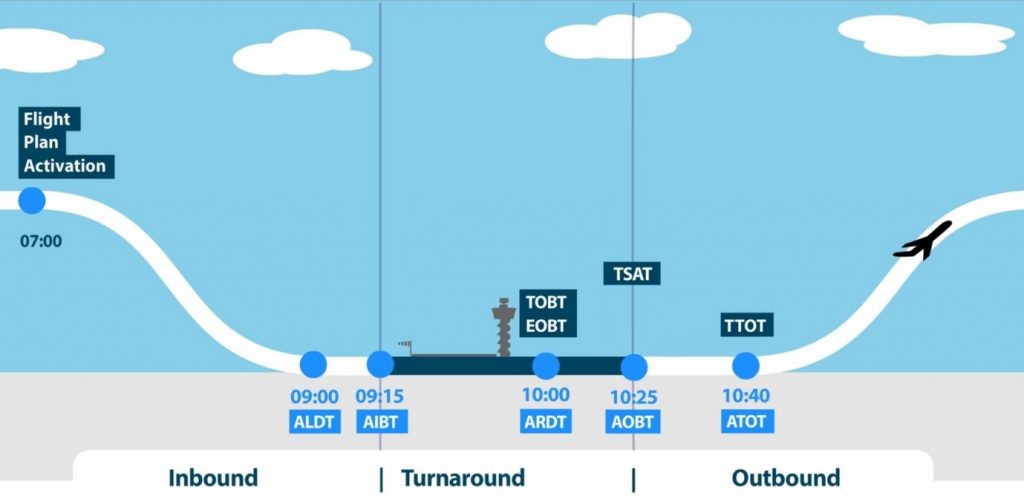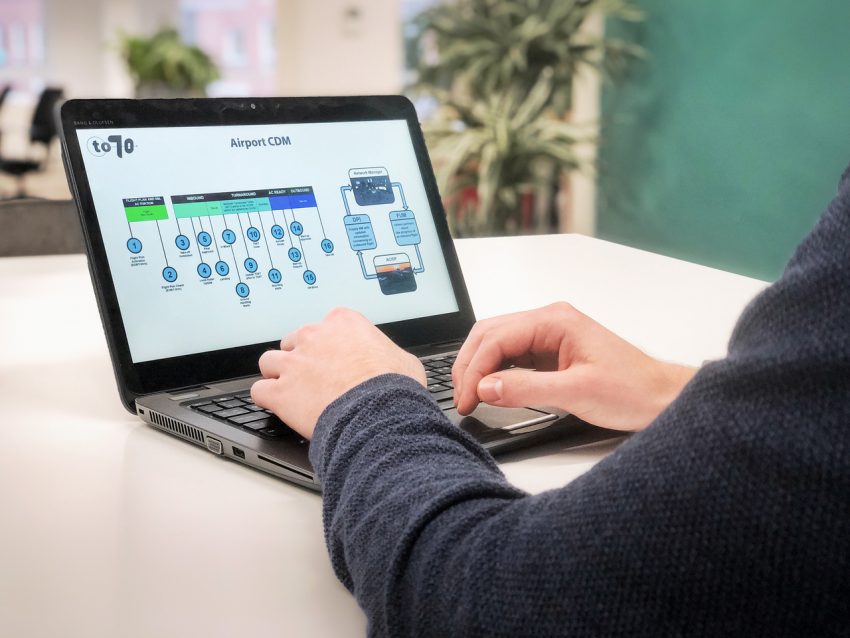Setting up A-CDM in pursuit of efficiency and predictability is a considerable investment for an airport. Once implemented, airports need to focus on the real ROI that A-CDM provides: the ability to continuously improve operational processes. All too often, however, the initial returns begin to diminish as trained staff move on to new positions and others with little or no A-CDM training take their place.
[blockquote text=”As with any change management effort, the real success lies in embedding it in processes.” text_color=”#004361″ show_quote_icon=”yes”][vc_separator type=’transparent’ position=’center’ color=” thickness=’5′ up=” down=”]
The curse of diminishing returns
This lack of continuity can curb A-CDM benefits. Part of the problem is when organisations see A-CDM predominantly as a technological investment, in data-sharing platforms, predeparture sequencing tools and the like. It is surprising that, after more than a decade, some still see A-CDM as little more than a software solution. But as with any change management effort, the real success lies in imbedding it in processes. Keeping it embedded requires continuous training as the organisation changes and evolves.
It is perhaps understandable why relatively little effort is spent on continuous training. A-CDM is not only an abstract topic that needs to appeal to different stakeholders at different levels, it is also highly dynamic in nature. That can make developing a meaningful and future-proof training package quite challenging.
Effective Approach to A-CDM Training
Just a basic understanding of the A-CDM concept across the broader airside operations community is not enough to fully reap the rewards. The respective stakeholders each require training on their organisational and individual responsibilities. A turnaround coordinator’s role in A-CDM is completely different to that of air traffic control or airline OCC staff.
Hierarchical integration is also important, as senior management needs to understand – and endorse! – the concept as much as the hands-on operations on the apron.
A well-designed A-CDM training doesn’t only teach how things are done, but perhaps more importantly, it elaborates on the ‘why’ of certain actions and behaviours. Context, rationale and the impact of actions (and especially the consequences of NOT acting) are crucial to achieving the necessary buy-in from A-CDM partners to help deliver on performance targets.
E-Learning: A Sustainable Way to Train
In our years of experience implementing A-CDM, we regularly saw organisations underestimate the importance of training, sometimes even choosing to discontinue most of it once the project was delivered. Rostering group training days with classrooms, instructors and detailed PowerPoint presentations has an impact on resources and planning. We believe supporting continuous operational improvement is best benefited by a different type of training.

This is why To70 strongly advocates the use of e-learning to help enhance the returns on A-CDM. So strongly, in fact, that we developed our own series of e-learning modules for our A-CDM clients, consisting of 20-minute sessions that can be set up specifically with a client’s own content and design.
E-learning modules allow an organisation to cater to the needs of various roles, knowledge levels and usage intensity. Course completion targets can be easily set and tracked, and immediate content updates ensure that the latest operational developments are always available. Online accessibility means operational staff can train as needed or during idle time. These are just some of the reasons we believe e-learning is a far more sustainable A-CDM training solution.
Would you like to know more about To70’s A-CDM e-learning training modules? Get in touch and tell us about your A-CDM experiences, then let’s see how we can improve them! Would you likve to view our e-learning demo? Check out the following link here.
About To70. To70 is one of the world’s leading aviation consultancies, founded in the Netherlands with offices in Europe, Australia, Asia, and Latin America. To70 believes that society’s growing demand for transport and mobility can be met in a safe, efficient, environmentally friendly and economically viable manner. To achieve this, policy and business decisions have to be based on objective information. With our diverse team of specialists and generalists to70 provides pragmatic solutions and expert advice, based on high-quality data-driven analyses. For more information, please refer to www.to70.com.


Hi Kris,
I have a little dilemma with developing services such as long range flow management and outside influences into ATM (CDM) —-
Are technological changes affecting the definition of an air traffic service? What for instance is Flow Management or Collaborative Decision Making? Without going into vast detail how much of these new or changed services should be subject to Annex 10 or 11 technical and operational oversight?
Annex 11 – Air traffic flow management (ATFM). A service established with the objective of contributing to a safe, orderly and expeditious flow of air traffic by ensuring that ATC capacity is utilized to the maximum extent possible and that the traffic volume is compatible with the capacities declared by the appropriate ATS authority.
Annex 11 – Air traffic service. A generic term meaning variously, flight information service, alerting service, air traffic advisory service, air traffic control service (area control service, approach control service or aerodrome control service).
Annex 11 – Declared capacity. A measure of the ability of the ATC system or any of its subsystems or operating positions to provide service to aircraft during normal activities. It is expressed as the number of aircraft entering a specified portion of airspace in a given period of time, taking due account of weather, ATC unit configuration, staff and equipment available, and any other factors that may affect the workload of the controller responsible for the airspace.
How is the world dealing with, what I see as “technical cross-over” with possible risk from non-ATC inputs in to the ATC system?
Dear Geoff,
Thanks very much for your thoughtful question. I’ll attempt to respond to the two points you make: “I have a little dilemma with developing services such as long range flow management and outside influences into ATM (CDM)”; and “How is the world dealing with, what I see as “technical cross-over” with possible risk from non-ATC inputs in to the ATC system?”
I think that you might be well served with browsing the Global Air Navigation Plan ( https://www4.icao.int/ganpportal/ – it may be good to download the pre-web version at https://www.icao.int/publications/Documents/9750_5ed_en.pdf as it’s not changed much in substance and the PDF is easier to make sense of as a whole, in my opinion). The ICAO Doc 9854 Global ATM Operational Concept (GATMOC) also serves as excellent reference.
The general idea is that we have moved away from the “command and control” inwardly-focused concept of air traffic control to a concept of air traffic management that seeks to address the needs of the entire ATM Community (inclusive of airports, airlines, ANSPs and many others). One of the tools we apply is Collaborative Decision Making (which is something we started using in the mid-90s in some areas).
Non-ATC inputs are absolutely essential in achieving our collective goals!
We need to know what capacities are, on an end-to-end systemic basis. MET and other factors greatly influence airport and airspace capacities. Dynamically “publishing” capacities and constraints in a timely manner will allow airlines and other airspace users to adjust their demands in 4D. Dipping into the Airport CDM domain for a moment; managing the turnaround processes and ensuring that any Air Traffic Flow Management measures are tailored to real demand rather than planned demand help achieve the goals of making best use of available capacity. Some will argue that A-CDM increases declared capacity, as the ATM providers will be less likely to protect themselves by applying padding to the real capacity when declaring (and metering to) a capacity.
I apologize for being quite verbose. I hope this will shed a bit of light on the subject and I welcome any discussion 🙂
Hi Geoff,
Sorry for the delay to get back to you.
Airport CDM is a supporting activity, endorsed by ICAO that works to improve the accuracy of data used by ATC to deliver the ATFM Service required by Annex 11 Ch3: ATFM shall be implemented for airspace where air traffic demand at times exceeds, or is expected to exceed, the declared capacity of the air traffic control services concerned and thereby enhancing the predictability the ATS service.
Annex 11 Ch3 also states that:
When it becomes apparent to an ATC unit that traffic additional to that already accepted cannot be accommodated within a given period of time at a particular location or in a particular area, or can only be accommodated at a given rate, that unit shall so advise the ATFM unit, when such is established, as well as ATS units concerned. Flight crews of aircraft destined to the location or area in question and operators concerned shall also be advised of the delays expected or the restrictions that will be applied. Note.— Operators concerned will normally be advised, in advance where possible, of restrictions imposed by the air traffic flow management unit when such is established.
Airport CDM provides a collaborative communication method for the timely distribution this data to all stakeholders.
I hope this has clarified things for you.
Kris